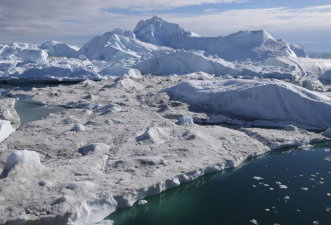Global sea level change is a systemic phenomenon driven by variations in ocean volume and ocean basin morphology. It is recorded through tide gauge observations and satellite altimetry data, the latter of which has sub-decimeter accuracy and can cover distant oceans.
Global sea level rise is primarily driven by thermal expansion of ocean water and glacial melting. The rate of rise increased from 1.3 mm/year to 3.7 mm/year between 1901 and 2018, reaching its highest level since satellite records began in 2024. Climate change is accelerating the melting of the Greenland ice sheet (approximately 30 million tons of ice per hour), and complete melting of the Antarctic ice sheet could cause sea levels to rise by 70 meters. Projections indicate that global sea levels could rise by as much as 1.02 meters by 2100 under a high-emissions scenario, threatening coastal cities and island nations.
A seemingly small figure of 4.3 centimeters per decade in sea level rise is posing a "catastrophic" threat to Pacific island nations. On July 23, 2025, the International Court of Justice issued a landmark ruling requiring all countries to make "maximum efforts" to prevent climate catastrophe, with industrialized nations taking the lead. This lawsuit, initiated by Vanuatu and other island nations, has brought the survival crisis of small nations to the global judicial stage.
A "Centimeter-Level" Death Countdown in the Pacific
NASA satellite monitoring shows that global sea levels will rise by 5.8 millimeters in 2024, a 30-year high. In parts of the Pacific, the actual increase far exceeds the global average. Ninety percent of Kiribati's landmass is less than three meters above sea level, and Tuvalu's highest point is only 4.5 meters. Another meter of sea level rise would sink these nations underwater.
Saltwater intrusion is poisoning the lifeblood of island nations. Freshwater resources are being infiltrated by seawater, and farmland is being abandoned due to salinization. Vanuatu's Attorney General, Arnold Kiel Rockman, stated in court: "The survival of my people is at stake."
Background
Sea level rise is a global phenomenon caused by global warming, melting polar ice caps, and the expansion of upper ocean waters due to heat. Research has shown that global sea levels have risen by 10 to 20 centimeters over the past century, and the trend of rising sea levels is expected to accelerate in the future. However, when studying actual sea level changes in a specific region of the world, we must also consider the impact of local vertical land movement—slow crustal uplift and subsidence—and local land subsidence. The sum of global sea level rise and local land uplift is the relative sea level change for that region. Therefore, studying sea level rise in a particular region is only meaningful if we examine its relative sea level rise. Sea level rise is a slow-onset natural disaster for human survival and economic development. According to the United Nations Environment Programme, nearly half of the world's population (approximately 3 billion people) lives within 200 km of the ocean, and two-fifths of cities with a population of over one million are located in coastal areas. If sea level rises by 1 meter, 5 million square kilometers of land will be inundated globally, affecting over 1 billion people and one-third of the world's arable land.
Influencing Factors
- The Effect of Rising Sea Temperatures on Sea Level Change
Over the next 100 years, thermal expansion is considered the most significant factor contributing to sea level rise. Due to the ocean's enormous heat capacity, there's a significant delay before surface heat is fully transferred to the ocean's depths. Consequently, the ocean will never reach equilibrium, and global sea level will continue to rise even after atmospheric greenhouse gas concentrations stabilize. Thermal expansion of ocean water is a major factor influencing sea level rise. Cabanes first discovered the impact of thermal expansion on sea level rise in 1998. However, global thermal expansion is not uniform, with significant variations across long and large spatial scales. For example, warming in the Indian Ocean began in the 1960s, while the Atlantic Ocean began to warm significantly about 30 years later. Therefore, global sea level changes exhibit regional characteristics, and the thermal expansion curve exhibits a decadal cycle that remains unexplained.
- The Impact of Salinity on Sea Level Change
Ocean salinity changes have significant implications for local and seasonal variations in seawater density and sea level, but their impact on global mean sea level is minimal. In recent years, researchers have pointed out that the impact of salinity changes on sea level rise over the past 50 years is about 0.05 mm/a, which is significantly smaller than the impact of thermal expansion. Antonov [11] converted the salinity change and the amount of fresh water injected into the ocean in proportion and found that the ocean freshening process is equivalent to a sea level rise of 1.35±0.5 mm/a. It should be noted that the melting of sea ice and icebergs will reduce salinity, but will not increase sea level. Their impact should be taken into account in the calculation, and their recent melting rate is accelerating.
- The impact of land water bodies on sea level changes
Since the 20th century, due to global warming, mountain glaciers have been retreating, especially in the past 10 years, and the retreat rate has accelerated. According to scientists' research data, the impact of mountain glaciers on sea level is about 0.66 mm/a. Although mountain glaciers only account for a small part of land glaciers, their impact on sea level changes is second only to the thermal expansion of seawater. The Antarctic and Greenland ice sheets hold approximately 99% of Earth's surface freshwater. If they were to melt completely, global sea levels would rise by approximately 70 meters. Even a small amount of melting would have a significant impact on sea level. Due to the different land-sea distribution and topographical features of Greenland and Antarctica, the melting characteristics of the ice sheets differ: on the Antarctic continent, ice sheet loss occurs primarily through melting at the base of the ice shelves and the detachment of icebergs, with minimal surface melting. On the Greenland ice sheet, mass loss is primarily through surface melting and iceberg calving. Rignot suggests that the rate of ice sheet melt has accelerated in recent years, with ice shelf thickness decreasing. Recent observations indicate that the ice sheet mass budget has contributed to a sea level rise of 0.3 ± 0.1 mm per year over the past decade. Furthermore, human activities can alter the circulation and routes of terrestrial waters, also impacting sea level change. Groundwater extraction, fossil fuel combustion and biodegradation, deforestation, artificial lake construction, and irrigation all have an impact on sea level. Combined with human activities, the impact on sea level ranges from approximately -1.1 to 0.4 mm/year.
- The Impact of Geophysical Processes on Sea Level Change
The Earth is a plastic sphere. Changes in its shape during glacial and interglacial periods can cause sea level rise and fall. About 1 million years ago, Earth entered a glacial period. Following the Quaternary glacial period, the period lasting approximately 10,000 years is called the postglacial period. This period continued to experience numerous low-level fluctuations in temperature. Glacial periods can alter the distribution of surface water bodies, the distribution of global climate zones, and influence crustal rise and fall. Over the past 20 years, models of postglacial land rebound have been gradually refined. These models describe changes in Earth's shape, ice sheet changes, and ocean geometry and volume during glacial and interglacial periods. The impact of land rebound on sea level is approximately 0.3 mm/year.






